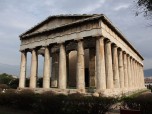The 19th century saw the construction of many beautiful Greek buildings in Athens. The Academy of Athens is one of the most awe-inspiring buildings of them all. With inspiration driven by the infamous Acropolis, the Academy utilizes many elements from ancient Greek architectural design.
History
In modern day standards, 19th century Athens was considered a very tiny town. Its ancient ruins and cramped roads provided little room for new construction and expansion. All of the town’s roads and buildings stood huddled together around the remains of historical structures.
That all changed when Greece obtained their freedom. Athens was named the capital of the state in 1832 and with that came the opportunity to expand into a cultural center. The independence of Greece meant that major renovations could be done to the capital’s design structure. New construction began on important establishments for education and the government. A university, parliament and palace were among a few of the construction projects to be completed during this time. In addition, the Academy of Athens was built to house the country’s national college.
Construction
Theophil Hansen was in charge of the architectural plans for the Academy. Having formal architecture training in Austria, he also designed the library and university. The Athenian Trilogy is the name given to the three historic buildings that are constructed near each other.
Although the other buildings are of the same time and inspiration, the construction elements of the Academy far out-do the other buildings. Precious marble stones taken from Mount Pentelicus were used in the construction of the Academy and took over thirty years to make. Ernst Ziller was the head architect and a protégé of the Austrian Theophil Hansen. All of the expensive materials were financed by a very well-off entrepreneur by the name of Simon Sinas. He was the founder of the National Bank of Austria and a prominent government official in Vienna.
Design
The Academy is comprised of a series of temples that honor the ancient Greek culture. Using the Ionic style of architecture, the exterior is intricately designed with ancient Greek sculptures adorning the outside of the temples. The statues are inspired by the Parthenon and give homage to the goddess Athena.
The god Apollo was also given a statue that sits atop an intricately designed Ionic column. Leonidas Drosis was the sculpter that designed many of the statues that are found around the Academy. His depiction of Apollo consists of the god holding a lyre in order to represent poetry and music. Drosis also created statues of Plato and Socrates, two Greek philosophers that have influenced a discipline of study for centuries. The two are shown seated at the steps of the building.
Inside of the Academy are large beautiful paintings by the artist Christian Griepenkerl. The German painter showcased the tale of Prometheus and his dealings with the god Zeus. The Greek myth was popular during that time because of its symbolism. In addition, during the 19th century the story of Prometheus provided hope to people seeking a better political climate.





















